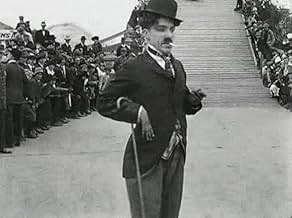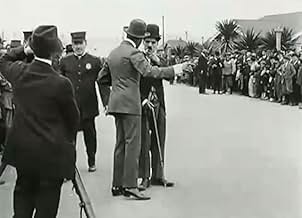ÉVALUATION IMDb
5,7/10
3,5 k
MA NOTE
Ajouter une intrigue dans votre langueThe Tramp wanders into and disrupts the filming of a go-kart race.The Tramp wanders into and disrupts the filming of a go-kart race.The Tramp wanders into and disrupts the filming of a go-kart race.
- Director
- Writers
- Stars
- Prix
- 1 victoire au total
Avis en vedette
Kid Auto Races at Venice is far from Chaplin's best moment on film, but it might be his most important. In an early combination of the reality short subjects that dominated early cinema, and fictional comedy, this short piece features Chaplin as a tramp who annoys several camera crews at a car race.
As the first appearance of Chaplin's Tramp character, this film's place in movie history is secure. As a comedy, it's mildly amusing. Obviously ad libbed, it has an amateurish quality that holds up surprisingly well. It also provides a few thrills as Chaplin is nearly hit by the vehicles several times -- I doubt any of the near-misses were scripted!
There is no denying that this short film is not an example of Chaplin's best work on film, but every serious Chaplin fan, or cinema historian, needs to see it at least once.
As the first appearance of Chaplin's Tramp character, this film's place in movie history is secure. As a comedy, it's mildly amusing. Obviously ad libbed, it has an amateurish quality that holds up surprisingly well. It also provides a few thrills as Chaplin is nearly hit by the vehicles several times -- I doubt any of the near-misses were scripted!
There is no denying that this short film is not an example of Chaplin's best work on film, but every serious Chaplin fan, or cinema historian, needs to see it at least once.
Tramp's first appearance and... he's a punk. Fun and meta at first, at least in the way that it's a movie about movie-making at a time when that was a fresh idea, but wears out its welcome as it's a one-note gag. There's not really any of Chaplin's great comically timed physical gags, it's just him being an a-hole getting in the way of a camera crew as they try to get footage of cars racing by. I wish there was more to it as Chaplin clearly already owns the role, but there's none of the charm or innocence yet. Guess these things would take time to alter, though unlike, say, Mickey Mouse's early appearances (comparing to iconic comic figures of the early 20th century), being an ass doesn't suit the Tramp so well, at least not to this extent (if maybe he'd just interacted with another character or built upon something that'd be one thing).
In 1914 Charlie Chaplin debuted with the Mack Sennett shorts for Keystone. These shorts were made in rapid succession and while some are great, some are ok (like this one) and some are bad. Despite the results they were all released in theaters. These early shorts are pretty much like home videos (like the ones played on AMERICA'S FUNNIEST VIDEOS) with people that do stupid things and in the end they have pratfalls. His tramp character (that debuted here) was still evolving as he switched to Essenay studios a year later. He stopped this evolution process with his full-length movies in the 1920s.
In this short, as I said in the summary, there isn't much plot. The Keystone crew went on a kid auto race and they told Chaplin to just wander around and coming in and out of the track. The only thing that happens beside this is that he is sometimes punched by few adults for getting in the track. The only thing for which this short is important is because we have a first shot of Chaplin's most famous character.
In this short, as I said in the summary, there isn't much plot. The Keystone crew went on a kid auto race and they told Chaplin to just wander around and coming in and out of the track. The only thing that happens beside this is that he is sometimes punched by few adults for getting in the track. The only thing for which this short is important is because we have a first shot of Chaplin's most famous character.
The Keystone period of Chaplin's work (1914) always suffers in comparison to his later films, especially the Mutuals and First Nationals. This is because he was still learning his craft, but mostly because Mack Sennett kept making the same film over and over again. While the majority of Keystones are indistinguishable from one another, this short subject, only Charlie's second, towers above the others. Here Chaplin attends an actual event in Venice (California) as a spectator pretending to be unaware that he is constantly getting in the cameraman's frame. Time has been positively affectionate to this film; appearing on camera is now a national pastime, and being a split reel it clocks in at about the same length as a Saturday Night Live skit. This film deserves your attention. It won't take long.
... who don't even know that they are the cast. You could do this sort of thing back before there were too many lawyers and too many laws. This is the first time that Chaplin dons the "Little Tramp" persona with his bowler, cane, tight coat, and baggy pants, although it was his second film.
He merely gets in the way of the crowd and the cameramen trying to film said Kid Auto Races at Venice, actually the Junior Vanderbilt Cup race. There is no evidence this race was held prior to or after 1914. Some carts had engines, some did not.
The point is, all of these spectators and relatives are very interested in the outcome of the race, as are the cameramen trying to photograph the event. And this obnoxious fellow keeps stumbling into the street, blocking their view, getting into the line of sight of the cameras, and spectators and cameramen keep pushing him out only to have him stumble back into the street and in the way.
Eventually some of the spectators are actually watching this clown and laughing at him rather than being annoyed. That was the magic of Chaplin even from the beginning. Notice that there are some cops around and that they have no guns, even in a semi-urban setting like this. Also note that they don't interfere with Chaplin. Did the director let the cops in on the joke, maybe give them a few bucks to let them make their movie and then leave? Maybe.
When you watch this, understand that until just a short time before, movies were just "actualities" - the filming of ordinary events such as people going to and from work and the tearing down of a building. Just the year before Chaplin had been a performer in music halls. His relationship to motion pictures was brand new.
This was shot in February 1914, six months before WWI begins and three years before America enters that war. Not quite two years after the sinking of the Titanic, just to give some perspective.
He merely gets in the way of the crowd and the cameramen trying to film said Kid Auto Races at Venice, actually the Junior Vanderbilt Cup race. There is no evidence this race was held prior to or after 1914. Some carts had engines, some did not.
The point is, all of these spectators and relatives are very interested in the outcome of the race, as are the cameramen trying to photograph the event. And this obnoxious fellow keeps stumbling into the street, blocking their view, getting into the line of sight of the cameras, and spectators and cameramen keep pushing him out only to have him stumble back into the street and in the way.
Eventually some of the spectators are actually watching this clown and laughing at him rather than being annoyed. That was the magic of Chaplin even from the beginning. Notice that there are some cops around and that they have no guns, even in a semi-urban setting like this. Also note that they don't interfere with Chaplin. Did the director let the cops in on the joke, maybe give them a few bucks to let them make their movie and then leave? Maybe.
When you watch this, understand that until just a short time before, movies were just "actualities" - the filming of ordinary events such as people going to and from work and the tearing down of a building. Just the year before Chaplin had been a performer in music halls. His relationship to motion pictures was brand new.
This was shot in February 1914, six months before WWI begins and three years before America enters that war. Not quite two years after the sinking of the Titanic, just to give some perspective.
Le saviez-vous
- AnecdotesThis was the first film in which Charles Chaplin played his most famous character, The Tramp. With only a small number of exceptions, Chaplin would play only The Tramp (or slight variations on the character) on film until Le dictateur (1940).
- ConnexionsEdited into When Comedy Was King (1960)
Meilleurs choix
Connectez-vous pour évaluer et surveiller les recommandations personnalisées
Détails
- Date de sortie
- Pays d’origine
- Sites officiels
- Langues
- Aussi connu sous le nom de
- Kid Auto Races in Venice, Calif.
- Lieux de tournage
- 1300 Main Street, Los Angeles, Californie, États-Unis(intersection where filming took place)
- société de production
- Consultez plus de crédits d'entreprise sur IMDbPro
- Durée
- 11m
- Couleur
- Mixage
- Rapport de forme
- 1.33 : 1
Contribuer à cette page
Suggérer une modification ou ajouter du contenu manquant






















